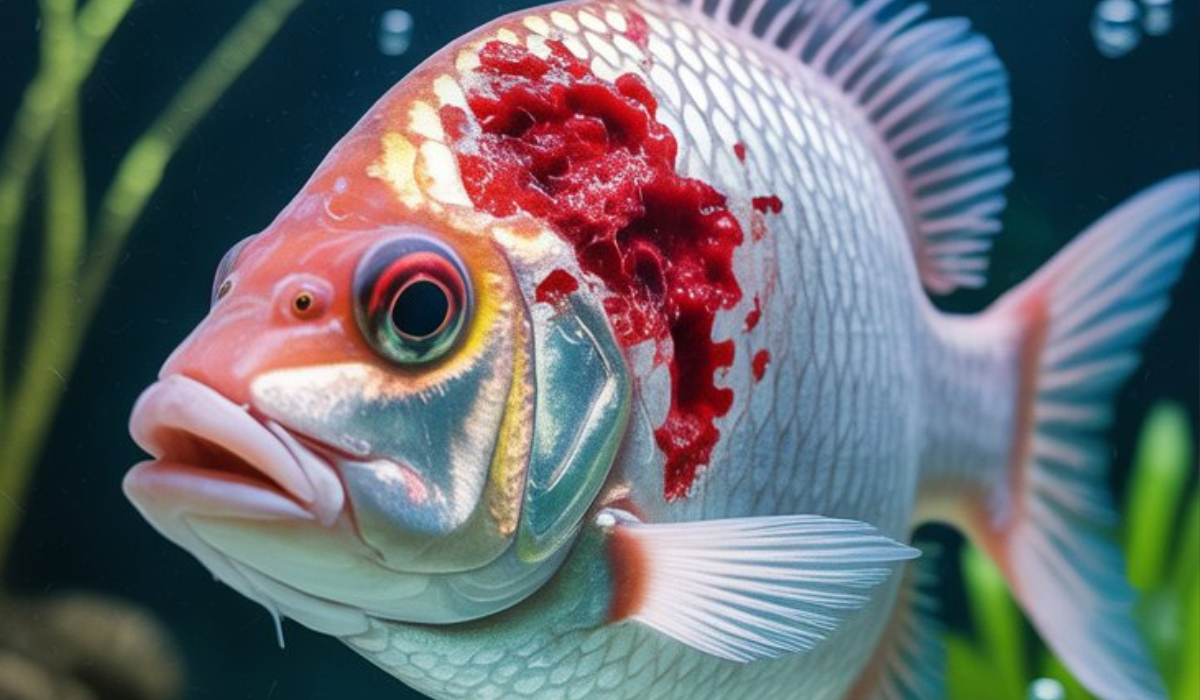Fish Hemorrhagic Disease is one of the most alarming and economically significant diseases in aquaculture and wild fish populations. It is characterized by bleeding (hemorrhaging) under the skin, around fins, and in internal organs. The condition affects both freshwater and marine fish species and is mainly caused by viral, bacterial, or environmental factors.
This disease leads to high mortality rates, especially in crowded fish farms, and can devastate commercial aquaculture operations if not managed properly. Understanding the causes, symptoms, diagnosis, and prevention methods of Fish Hemorrhagic Disease is essential for fish keepers, aquarists, and aquaculture professionals to maintain healthy fish populations.
In this comprehensive guide, we’ll explore every aspect of Fish Hemorrhagic Disease — its causes, how to identify it early, effective treatment options, and best practices for prevention.
What Is Fish Hemorrhagic Disease?
Fish Hemorrhagic Disease refers to a group of disorders in which fish experience internal and external bleeding due to infections or toxic environmental conditions. The most common and severe form is Viral Hemorrhagic Septicemia (VHS), a contagious disease caused by the Viral Hemorrhagic Septicemia Virus (VHSV).
However, similar hemorrhagic symptoms may also occur due to bacterial infections (like Aeromonas hydrophila), parasitic infestations, or poor water quality. These factors damage blood vessels and tissues, resulting in bleeding and tissue necrosis.
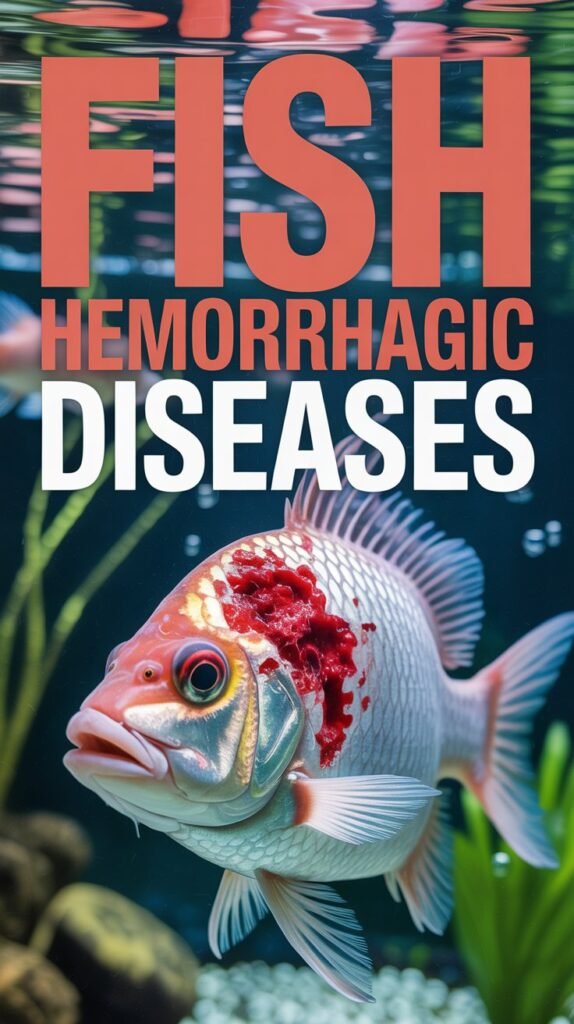
Hemorrhagic disease can affect both wild and farmed fish species such as:
- Trout
- Salmon
- Carp
- Catfish
- Tilapia
- Guppies
- Goldfish
The disease can cause mass die-offs, especially in confined aquaculture systems, making it one of the biggest challenges for fish farmers globally.
Types of Fish Hemorrhagic Diseases
There are several types or causes of hemorrhagic disease in fish, depending on the pathogen involved. The most notable are:
1. Viral Hemorrhagic Septicemia (VHS)
VHS is caused by Viral Hemorrhagic Septicemia Virus (VHSV), belonging to the Rhabdoviridae family. This virus infects both freshwater and marine fish. It spreads rapidly through water, contact with infected fish, and contaminated equipment.
Affected species: Salmon, trout, perch, pike, and many others.
Symptoms include:
- Bleeding around the eyes, mouth, and fins
- Swollen abdomen
- Lethargy and erratic swimming
- Pale gills and bulging eyes
- Sudden high mortality
VHS is one of the most dangerous fish viruses because of its wide host range and ability to persist in water for long periods.
2. Bacterial Hemorrhagic Septicemia (BHS)
This form is caused by Aeromonas hydrophila, Pseudomonas fluorescens, or Vibrio species. These bacteria infect fish when the immune system is weakened due to stress, overcrowding, or poor water conditions.
Common in: Freshwater fish such as carp, goldfish, and catfish.
Symptoms include:
- Red streaks along the body and fins
- Ulcers or open sores
- Abdominal swelling
- Cloudy eyes
- Loss of appetite
Bacterial hemorrhagic septicemia often occurs secondary to poor environmental management and can spread quickly in warm, stagnant waters.
3. Environmental or Toxic Hemorrhagic Disease
Sometimes, fish develop hemorrhages not due to infection but because of toxic substances, ammonia poisoning, or oxygen depletion. High levels of ammonia or nitrite in aquarium or pond water can burn fish tissues, leading to bleeding under the skin and gills.
Causes include:
- Poor filtration
- Overcrowding
- Overfeeding leading to decaying waste
- Contaminated or polluted water sources
This type of hemorrhagic condition can often be reversed by improving water quality and reducing stress.
4. Parasitic Hemorrhagic Disease
Parasitic infestations caused by Ichthyophthirius multifiliis (Ich), Gyrodactylus, or Dactylogyrus can also lead to hemorrhagic symptoms when parasites damage fish skin and blood vessels.
Typical symptoms:
- Tiny white spots (Ich)
- Red patches where parasites attach
- Rapid gill movement due to irritation
- Flashing or rubbing against surfaces
Though less lethal than viral hemorrhagic septicemia, untreated parasitic infections can still lead to secondary bacterial infections and bleeding.
Causes of Fish Hemorrhagic Disease
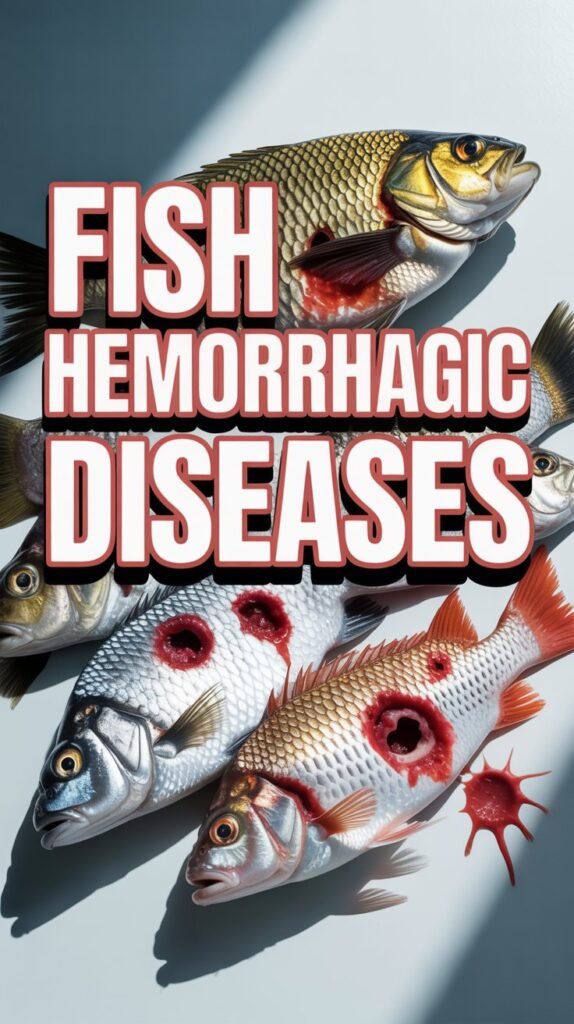
The causes of Fish Hemorrhagic Disease can be divided into infectious and non-infectious categories.
1. Infectious Causes
- Viruses: Viral Hemorrhagic Septicemia Virus (VHSV) is the main cause of hemorrhagic disease outbreaks.
- Bacteria: Aeromonas hydrophila, Vibrio anguillarum, and Pseudomonas fluorescens cause bacterial hemorrhagic septicemia.
- Parasites: Skin and gill parasites create entry points for secondary bacterial infections.
2. Non-Infectious Causes
- Poor Water Quality: High ammonia, nitrite, or nitrate levels damage tissues and blood vessels.
- Low Oxygen Levels: Cause stress and reduce immune function.
- Temperature Stress: Sudden temperature fluctuations weaken fish resistance.
- Overcrowding: Increases stress and disease transmission.
- Nutritional Deficiencies: Lack of vitamins (especially Vitamin C) weakens capillaries and increases hemorrhage risk.
Symptoms of Fish Hemorrhagic Disease
Recognizing the signs of Fish Hemorrhagic Disease early can save your fish and prevent large-scale losses.
External Symptoms:
- Red streaks on fins, mouth, or body
- Blood spots or bruises under the skin
- Swollen belly (ascites)
- Pale or discolored gills
- Bulging eyes (exophthalmia)
- Ulcers or open wounds
- Fin and tail rot
- Erratic or slow swimming
Internal Symptoms:
- Bleeding in liver, kidney, and spleen
- Fluid accumulation in the abdomen
- Enlarged internal organs
- Tissue necrosis
Behavioral Signs:
- Lethargy or floating near the surface
- Loss of appetite
- Disorientation or spinning movement
- Rapid breathing or gasping for air
Fish with these symptoms should be isolated immediately to prevent disease spread.
Diagnosis of Fish Hemorrhagic Disease
Diagnosing Fish Hemorrhagic Disease involves observing symptoms and conducting laboratory tests.
1. Visual Examination
Observation of red patches, ulcers, or abnormal swimming behavior gives initial clues.
2. Microscopic Analysis
Samples of skin, gills, or internal organs are examined under a microscope to detect bacterial or parasitic infections.
3. Bacterial Culture
If bacterial infection is suspected, swabs from lesions are cultured to identify the pathogen and determine antibiotic sensitivity.
4. Viral Tests
PCR (Polymerase Chain Reaction) or ELISA tests are used to confirm the presence of Viral Hemorrhagic Septicemia Virus.
5. Water Quality Testing
Checking ammonia, nitrite, nitrate, pH, and oxygen levels helps determine whether environmental factors are contributing to hemorrhagic symptoms.
Treatment of Fish Hemorrhagic Disease
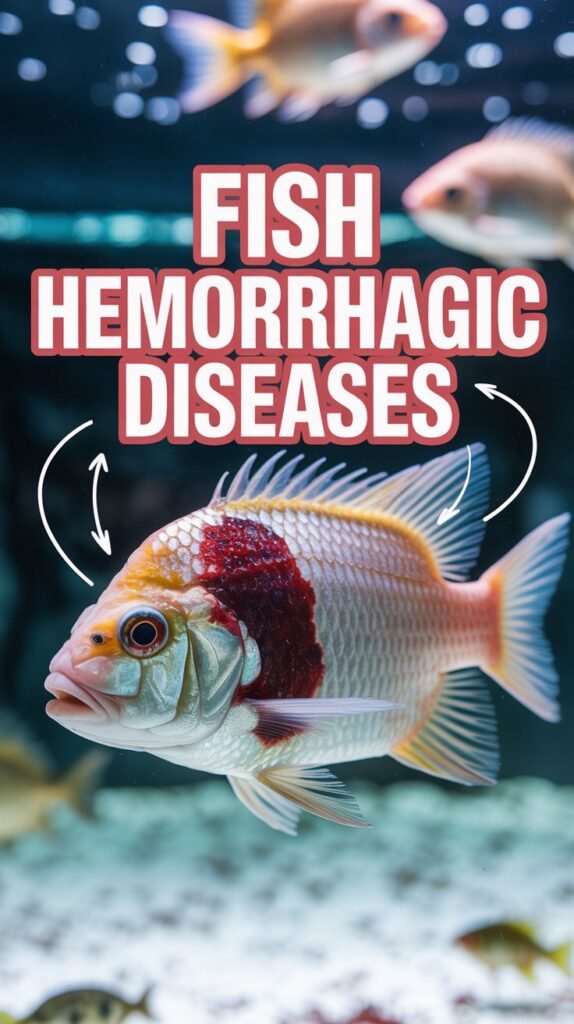
The treatment of Fish Hemorrhagic Disease depends on the underlying cause — viral, bacterial, or environmental.
1. Treatment for Viral Hemorrhagic Septicemia
Unfortunately, there is no direct cure for viral infections like VHS. Infected fish must be isolated or euthanized to prevent transmission.
Management includes:
- Immediate quarantine of affected fish
- Disinfection of tanks, nets, and equipment
- Improving water quality and reducing stress
- Using antiviral immune boosters (commercial fish tonics and immunostimulants)
2. Treatment for Bacterial Hemorrhagic Septicemia
Bacterial infections can often be treated if caught early.
Steps to follow:
- Antibiotic treatment: Use antibiotics such as oxytetracycline, kanamycin, or erythromycin under veterinary guidance.
- Salt baths: A mild salt bath (1–3 grams of salt per liter) helps reduce stress and kill external bacteria.
- Water changes: Replace 25–50% of water daily to maintain quality.
- Feed medicated food: Mix antibiotics or natural remedies like garlic or turmeric with fish feed to enhance immunity.
3. Environmental and Toxic Causes
If hemorrhagic symptoms result from water pollution or toxins:
- Perform immediate 50% water change.
- Clean filters and remove waste or uneaten food.
- Check and stabilize water parameters (ammonia 0 ppm, nitrite 0 ppm, nitrate below 40 ppm).
- Add activated carbon filters to remove toxins.
- Use water conditioners that detoxify ammonia and chlorine.
4. Parasitic Treatment
If parasites are the cause, use:
- Formalin or malachite green baths (only in correct dosages).
- Copper-based medications for external parasites.
- Salt dips to relieve irritation and kill surface parasites.
Always follow dosage instructions carefully to avoid harming fish.
5. Supportive Care
Regardless of cause, all infected fish should receive supportive care:
- Keep water temperature stable.
- Provide high-quality food rich in vitamins (especially Vitamin C and E).
- Reduce lighting and noise to minimize stress.
- Add beneficial bacteria to restore biological balance.
Prevention of Fish Hemorrhagic Disease
Preventing Fish Hemorrhagic Disease is far more effective and economical than treating it after an outbreak.
1. Maintain Excellent Water Quality
- Test water parameters weekly.
- Perform regular water changes (20–30% weekly).
- Avoid overfeeding — remove uneaten food promptly.
- Ensure adequate aeration and filtration.
2. Quarantine New Fish
Always quarantine new fish for 2–4 weeks before adding them to your main tank or pond to prevent introducing pathogens.
3. Disinfect Equipment
Regularly disinfect nets, buckets, and other tools using diluted bleach or potassium permanganate.
4. Avoid Overcrowding
Maintain appropriate stocking densities. Overcrowding increases stress, ammonia levels, and infection risk.
5. Strengthen Fish Immunity
Feed fish a balanced diet with vitamins, minerals, and probiotics. Supplements like garlic extract or beta-glucans can enhance resistance to diseases.
6. Temperature and Oxygen Management
Keep temperature and oxygen levels consistent. Sudden fluctuations can trigger disease outbreaks.
7. Regular Monitoring
Inspect fish daily for abnormal behavior, injuries, or color changes. Early detection allows faster response.
8. Biosecurity Practices in Aquaculture
- Limit movement between ponds.
- Use separate equipment for each tank.
- Dispose of dead fish properly to prevent contamination.
- Sterilize incoming water supplies.
Fish Species Most Affected
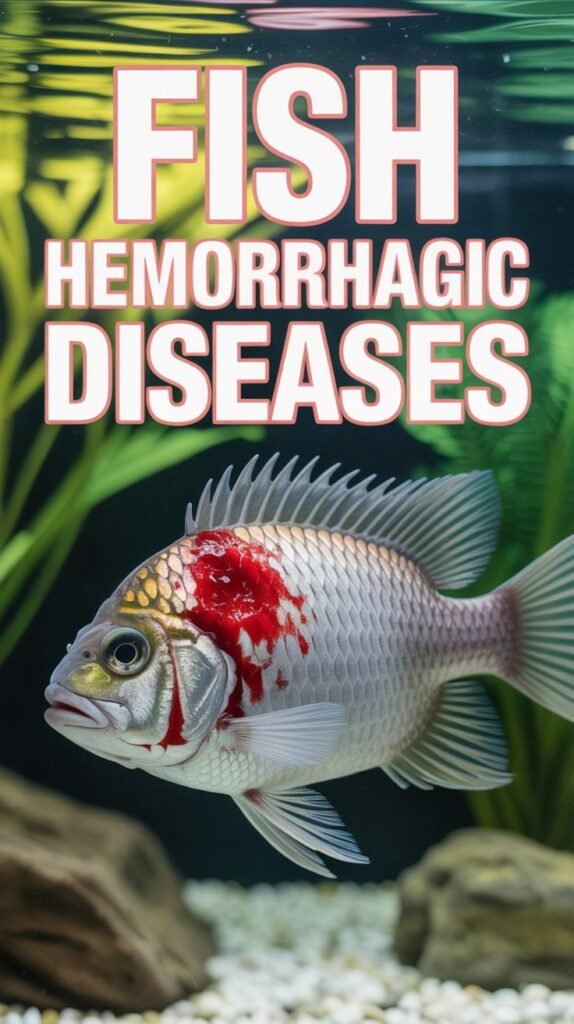
While Fish Hemorrhagic Disease can affect many species, the most susceptible include:
- Trout and Salmon: Common hosts for Viral Hemorrhagic Septicemia.
- Carp and Goldfish: Prone to Aeromonas-induced hemorrhagic septicemia.
- Tilapia and Catfish: Often affected in warm, low-oxygen environments.
- Guppies and Mollies: Susceptible in aquariums with poor water conditions.
Wild fish can act as carriers, spreading disease to farmed fish populations through shared water bodies.
Economic and Ecological Impact
Fish Hemorrhagic Disease poses severe economic risks to the aquaculture industry:
- High mortality rates in infected populations.
- Trade restrictions due to disease outbreaks.
- Reduced fish quality and growth rates.
- Costly disinfection and restocking efforts.
Ecologically, hemorrhagic disease can disrupt food chains, reduce biodiversity, and affect predator species relying on fish as a food source.
Prognosis
The prognosis for Fish Hemorrhagic Disease depends on early detection and management:
- Viral cases (VHS): Poor prognosis; prevention is key.
- Bacterial cases: Moderate prognosis with antibiotic treatment.
- Environmental cases: Good prognosis once water quality improves.
Fish that recover from mild cases may gain temporary immunity, but reinfection remains possible under stress.
Conclusion
Fish Hemorrhagic Disease is a serious condition that can devastate both hobbyist aquariums and commercial aquaculture systems. Caused by viruses, bacteria, parasites, or poor environmental conditions, it leads to bleeding, ulcers, and mass mortality if left unchecked.
The key to controlling this disease lies in prevention — maintaining clean water, providing balanced nutrition, avoiding overcrowding, and quarantining new fish. Regular monitoring, early diagnosis, and immediate corrective action can save fish populations from large-scale losses.
By understanding the causes and management of Fish Hemorrhagic Disease, fishkeepers and farmers can ensure healthy aquatic environments, sustainable production, and thriving fish populations.
Frequently Asked Questions (FAQs)
1. What is Fish Hemorrhagic Disease?
Fish Hemorrhagic Disease is a condition characterized by bleeding and tissue damage in fish, caused by viral, bacterial, parasitic, or environmental factors.
2. What causes Fish Hemorrhagic Disease?
It can be caused by Viral Hemorrhagic Septicemia Virus (VHSV), Aeromonas bacteria, parasites, or poor water conditions such as high ammonia and low oxygen levels.
3. How can I tell if my fish has hemorrhagic disease?
Look for red streaks, ulcers, swollen abdomen, pale gills, loss of appetite, and unusual swimming behavior.
4. Is Fish Hemorrhagic Disease contagious?
Yes. Viral and bacterial forms are highly contagious and can spread through water, equipment, and direct contact between fish.
5. Can Fish Hemorrhagic Disease be cured?
Viral forms cannot be cured, but bacterial and environmental forms can be treated through antibiotics, water changes, and improved care.
6. How do I treat bacterial hemorrhagic septicemia in fish?
Use antibiotics under expert supervision, perform regular water changes, and feed medicated food to strengthen immunity.
7. How can I prevent hemorrhagic disease in my fish tank?
Maintain clean water, avoid overcrowding, quarantine new fish, disinfect tools, and feed a balanced diet rich in vitamins.
8. Does hemorrhagic disease affect all fish species?
It can affect both freshwater and marine fish, but trout, salmon, carp, and catfish are among the most vulnerable species.
9. What water conditions lead to hemorrhagic symptoms?
High ammonia, nitrite, or nitrate levels, low oxygen, and sudden temperature fluctuations can cause stress and hemorrhagic signs.
10. Can humans catch Fish Hemorrhagic Disease?
No. The viruses and bacteria that cause hemorrhagic disease in fish do not infect humans, though good hygiene is always advised when handling sick fish.

